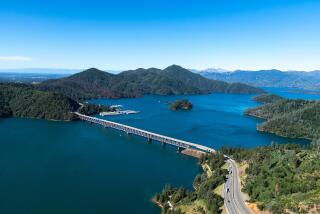Editorial: When California needs to flush its stormwater out to sea — and when it doesn’t
- Share via
As the March rains loosen more Southern California mud and fill more Northern California reservoirs, the state still flirts with drought and we still run short of water. Los Angeles is engineered to hustle filthy storm water to sea as quickly as possible, as if it were the evil fluid of the primordial abyss, yet we spend millions to import precious snowmelt from the Sierras. It’s all just water. Meanwhile, the Trump administration proposes to raise Shasta Dam in the far north of the state to capture more rainwater to send south, but Democrats resist. Does any of it make any sense?
It does, but it requires some time contemplating a map of California.
In vastly oversimplified terms, California has two great mountain ranges that run north-south. Smaller Pacific storms drop their payloads on coastal cities when rain clouds run into the lower, western ranges. The bigger, colder storms make it east to the Sierras before releasing their water as snow.
Los Angeles is engineered to hustle filthy storm water to sea as quickly as possible, as if it were the evil fluid of the primordial abyss.
But nothing is that simple. In fact the western ranges are crooked, and in Santa Barbara County they bend from north-south to east-west and form a horizontal wall that, at places in the San Gabriel and San Bernardino mountains, reaches two miles high. The coast, rather than face west, runs diagonally. The third side of this geographic triangle is formed by the so-called peninsular ranges — an odd name for mountains sitting deep within Southern California until you realize that geologically, they are the northern end of Baja California.
Squeezed into this small triangle, which runs roughly from Santa Barbara to San Diego and features an attractive climate and flat, buildable spaces, is half of California’s thirsty population of 39 million. Winter rains here are modest — except when they aren’t, when storms hit the sun-warmed south-facing horizontal mountain wall. The precipitation rarely gets cold enough to take the form of snow, so instead of piling up to melt during the spring and summer, as it does in the cold, west-facing Sierras, the water comes all at once, rushing suddenly from the mountains and through all those flat areas built out with homes. There it can turn into the sort of deadly mud that hit Montecito in January and again threatens areas on the mountainous margin of the Southern California triangle. It is the reason that in the 1930s engineers began the decades-long job of encasing the Los Angeles River in concrete, to move the fearsome water safely to sea.
The other half of California’s people, and two-thirds of its precipitation, are spread around the rest of the state. Central and Northern California have also seen their share of cataclysmic flooding over the years, but instead of trying to push the water out to sea as quickly as possible, they have tried to capture it in order to release it in the spring and summer, when it is needed for crops.
In fact, agriculture grew so big and so important that it quickly gulped down much of the annual snowmelt and began over-tapping groundwater. Now, between diversions of Sierra snowmelt for crops and for residents in the Southern California triangle and the Bay Area, and with the added pressure of drought, the water that used to flow down the Sacramento and San Joaquin rivers and out to San Francisco Bay is too paltry to sustain migrating salmon and other species.
That leaves us with this odd environmental juxtaposition: In Northern California, we hang on to too much storm water and instead need to send more of it to sea to prevent the ecosystem from collapsing. But in Southern California, where our concrete riverbeds sweep biological and other toxic hazards into the ocean to foul beaches and poison marine life, we must send less out to sea and instead hang on to more of it, capturing it and allowing it to percolate into our aquifers to be naturally cleansed and available for reuse in lieu of the Sierra water that we import in excess.
Meanwhile, why not raise Shasta Dam?
There are many reasons, including continued environmental degradation of the type we need to reverse, but let’s focus on something else: Shasta is part of the federal Central Valley Project, and its water is used on farm fields that contract for that water. But that relatively small group of farmers would not pay for the project; U.S. taxpayers would. Just as Los Angeles taxpayers financed the projects that quench their thirst with mountain water — the Owens Valley project, the State Water Project, the Colorado River project — the people who pay should generally be the people who benefit. That’s something to keep in mind when considering any dam or other water project.
Los Angeles County voters are likely to see a storm water tax ballot measure in November to allow us to finally make use of those hazardous pulses of rain. In the end, we may need to re-engineer the Southern California triangle to finally keep that water for ourselves, stop flushing it out to the ocean, and allow more Sierra water, farther north, to proceed to the sea.
Follow the Opinion section on Twitter @latimesopinion and Facebook
More to Read
A cure for the common opinion
Get thought-provoking perspectives with our weekly newsletter.
You may occasionally receive promotional content from the Los Angeles Times.










